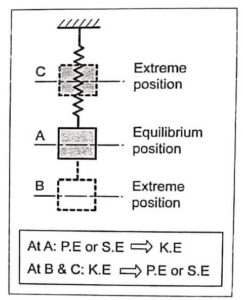- Any motion which repeats itself after an interval of time is called vibration or oscillation or periodic motion.
- All bodies possessing mass and elasticity are capable of producing vibrations.
- Vibration problems, in practice, occur wherever there are rotating or moving parts in a machinery. The study of vibration is concerned with oscillatory motions of the bodies and the forces associated with them.
- Illustration: Consider a spring-mass system constrained to move in a rectilinear manner along the axis of the spring.

When the mass is displaced from its equilibrium position A, the internal forces in the form of elastic or strain energy are present in the body; and hence the mass reaches position B.
At release, these forces bring the mass to its original position. At the equilibrium position A, the whole of the elastic or strain energy is converted into kinetic energy due to which the mass continues to move in the opposite direction to position C.
At C, the whole of the kinetic energy is again converted into elastic or strain energy due to which the body again returns to the equilibrium position A.
In this way, vibratory motion is repeated indefinitely and exchange of energy takes place.
Similarly, the swinging of simple pendulum is an another example of vibration as the motion of ball is to and fro from its mean position repeatedly.
Causes of Vibrations
The main causes of vibration are as follows:
- Unbalanced forces in the machine. These forces are produced from within the machine itself.
- Elastic nature of the system.
- Self excitations produced by the dry friction between the two mating surfaces.
- External excitations applied on the system.
- Winds may cause the vibrations in certain systems such as transmission and telephone lines under certain conditions.
- Earthquakes also cause vibrations and are greatly responsible for the failure of dams, many buildings.
Effects of Vibrations
- Negative effects: The existence of vibrating elements in any mechanical system produces unwanted noise, high stresses, wear, poor reliability and premature failure of one or more of the parts. In addition to this, vibrations are a great source of human discomfort in the form of physical and mental strains.
- Positive effects: Inspite of the harmful effects, the vibratory systems are built into the machines. Examples are almost all musical instruments, vibrating conveyors, vibrating screens, shakers, stress relievers, etc.
Methods of Elimination/Reduction of the Undesirable Vibrations
The undesirable vibrations can be eliminated or reduced by one or more of the following methods.
- By removing the causes of vibration.
- By resting the machinery on proper type of isolators.
- By using shock absorbers.
- By using dynamic vibration absorbers.
- By using the screens (if noise is the objection).
| Read More Topics |
| Natural frequency of free transverse vibration |
| Types of Balancing Machine |
| Piezoelectric pressure sensor |






